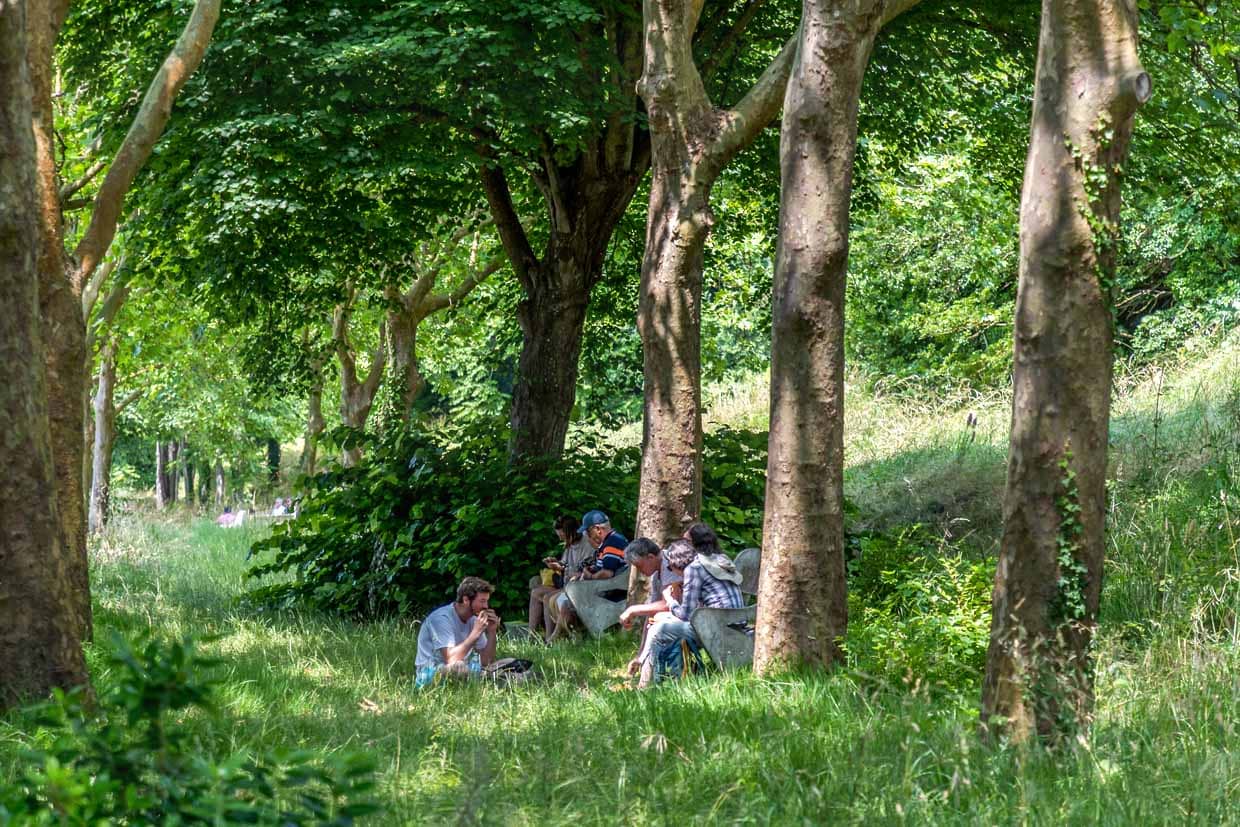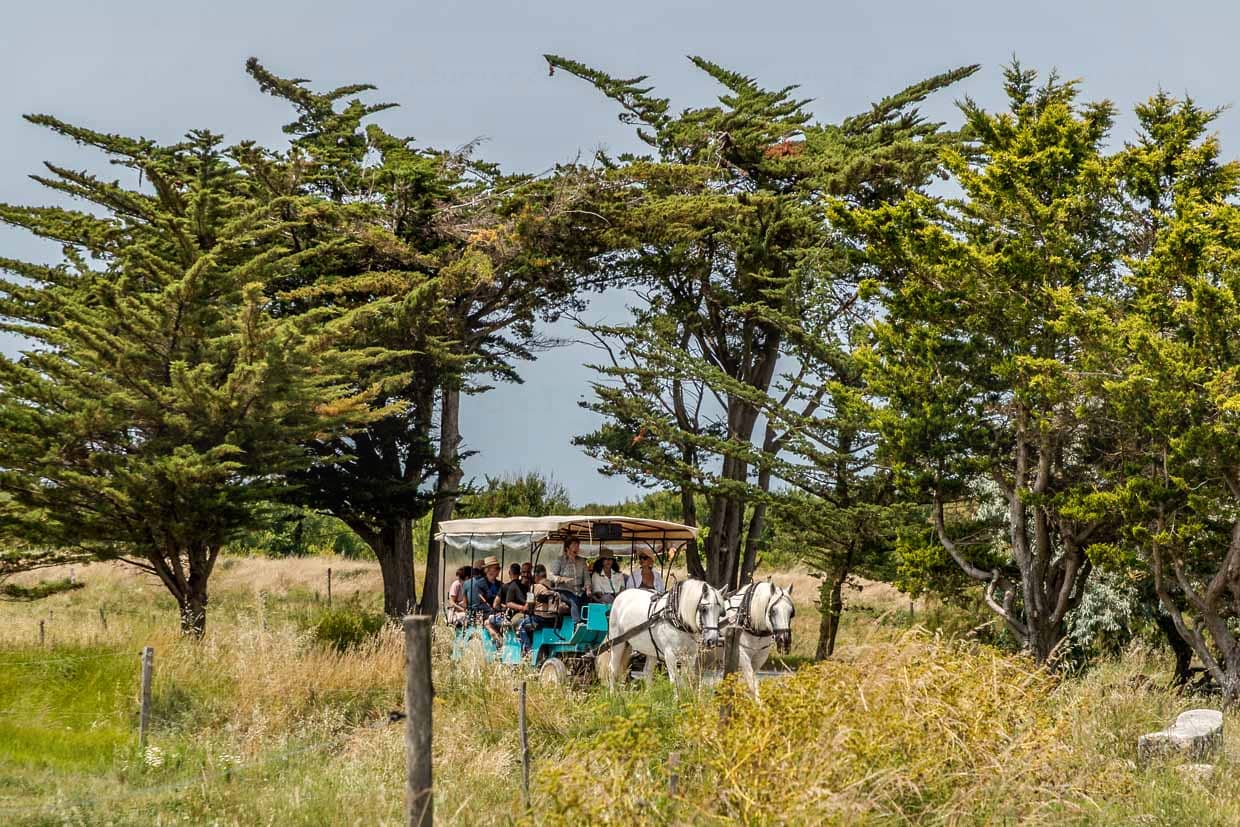The island of Aix is located in the Nouvelle-Aquitaine region, around 20 kilometers southwest of La Rochelle, close to the larger islands of Île de Ré and Île d’Oléron. A ferry takes visitors to the small island from Fouras – cars are not allowed here. The crossing only takes 20 minutes. At the jetty, the only village, Le Bourg, is hidden behind fortress walls. Green meadows run through the extensive fortifications and lead to two lighthouses. The island may be small, but it used to be an important bulwark.

The simple houses on the Île d’Aix shine with shutters in blue and turquoise. It’s a world of its own. You can explore the island by rental bike or on foot, roam through pine forests, discover another fort and reach small sandy beaches. In summer, day visitors flock to the village, but those who leave the village walls behind will find peace and quiet. Simple beach bars serve fresh seafood and light summer wines – a delight in the midst of the island idyll.

From outpost to vacation island
The small Île d’Aix is rich in history. It played a key role in Napoleon’s military strategy. It lies like a pebble at the mouth of the Charente. After his visit in 1808, Napoleon ordered the construction of powerful fortifications to keep enemy ships out of the Charente and to protect the naval arsenal of Rochefort from the British fleet. In 1810, construction began on Fort Liédot, the impregnable fortress designed by Napoleon. It had room for 600 men and later served as a prison.

Napoleon in the trap
After the defeat at Waterloo, Napoleon sought refuge here in July 1815. He spent three days in the commandant’s house on the Atlantic island and hoped to escape to America from there. But British ships blocked the Charente estuary. On the third day, he turned himself in and boarded a British warship as a prisoner, expecting to be treated with honor and sent into exile in England. But the British decided otherwise: they took him to the remote island of St. Helena in the South Atlantic. The governor’s house on the Île d’Aix is now the Napoleon Museum and commemorates his last days on French soil. The Emperor of the French died in exile in 1821.

A perfect summer’s day
The landscape of the Île d’Aix is varied with a mixture of sandy beaches, pine forests, salt marshes and oyster farms. More than half of the island is covered in forest. Cyclists can explore the island at their own pace. Pedestrians will not be able to see all the sights in a single day. But many visitors are particularly drawn to the sandy beaches, such as the Grand Plage or the Plage aux Coquillages, for a dip in the sea.

Coquillages and karaoke
A day by the sea calls for good food. On Aix, fresh seafood beckons: oysters, sea snails, scallops, clams, sea bass and eel. The oysters, which are farmed directly in the basins around the island, are considered a local delicacy. A recommended address is the bar-restaurant Chez Franck, just outside the fortified village. Owner Franck serves oysters and mussels at simple tables in the shade of large parasols – a meal typical of Aix.

With a bit of luck, Franck plays music himself. Towards the end of lunchtime, he likes to encourage his guests to karaoke. Energized by oysters and a little uninhibited by the wine, we follow his plan, grab the microphone and sing a song with great passion.



Varied all-round view
A walk across the Île d’Aix offers views of all the important surrounding islands and buildings. It quickly becomes clear that this island played a decisive role in the centuries of great naval battles. You can see the islands of Madame and Oléron, the Pertuis of Antioche, the Île de Ré with its bridge, La Rochelle, the Charente coast, the Pointe de la Fumée, the Fort Enet, the Fort Vauban in Fouras-les-Bains and the famous Fort Boyard.

Fort Boyard sits enthroned on a sandbank in the sea between the Île d’Aix and the Île d’Oléron. It can only be visited by boat. It gained worldwide fame thanks to the adventure game show Fort Boyard. Since 1990, the format has been adapted in over 33 countries and is considered the most successful French television export with a huge international audience. To this day, souvenirs related to the impregnable fort are very popular – such as a lockable tin money box.

Highlights in Nouvelle-Aquitaine
The Charente winds its way through the French region of Nouvelle-Aquitaine for 380 kilometres. Its course leads from the mountainous headwaters over rolling hills and vineyards to the maritime floodplains at the estuary. From Angoulême, the French capital of comics, the river is navigable all the way to the Atlantic at Rochefort. It was once the main transport route for cognac production. Today, cognac houses and winegrowers invite you to take part in spirit tourism, while cycle paths such as the Flow Vélo take you past picturesque villages, old stone bridges, a rare floating ferry, water mills, castles and the historic centre of Angoulême. The Charente is still an insider tip, as it is one of the most unspoilt river landscapes in France: hardly any mass tourism, but plenty of nature, tranquillity and enjoyment. The small island of Aix was once a bulwark to protect the Charente estuary from enemy fleets and is now a popular destination for a day trip to the sea. There is also plenty to discover in Nouvelle-Aquitaine away from the Charente. For example, some skewered plate art made us think outside the box once again. The city of Poitiers, halfway between Paris and Bordeaux, was the centre of power in the Middle Ages and offers immersive cinema at the Futuroscope leisure park. The city of Limoges is famous for its French porcelain, and a tour of the city provides an insight into the art of porcelain making. There are also great museums dedicated to the history of porcelain art . The journey continues to the Creuse and Berry region. It is the home of the writer George Sand and the cradle of tapestry in France. In A Carpet for George Sand, the two themes are linked. The Cité internationale de la Tapisserie in Aubusson shows that carpets are not the dusty art of bygone days.
The research trip was supported by Nouvelle-Aquitaine Tourism and Die Landpartie


